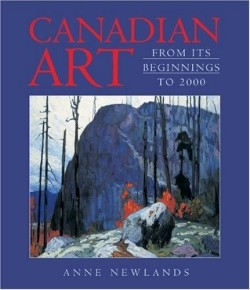Canadian Art
From Its Beginnings to 2000
On the front cover is the work of a Canadian icon, Lawren S. Harris. His 1920 oil on canvas, Algama Hill, is matched on the reverse cover by “one of the most famous images in Inuit art,” Kenojuak Ashevak’s The Enchanted Owl. Diverse techniques, a mosaic of cultural influences, and a host of mediums distilled over the course of time—this is Canadian art.
Newlands, an art museum educator at the National Gallery of Canada and author of three additional books on Canadian artists, wisely agreed to shun traditional chronological order and resisted grouping similar pieces, and thereby allow each work to be viewed keenly, without distraction and association.
An alphabetical order means that Michael Campeau’s black-and-white photographic self-portrait is followed by Joane Cardinal-Schubert’s rich series of paintings depicting a war shirt worn by her blood ancestors. Jacques Hurtubise’s geometric abstract painting, Isabelle, lies on the opposing page of Inuit artist Luke Iksiktaaryuk’s Drum Dance—a carving of antler with wood, sinew, metal, and gut. Dorothy Knowles’ vast sky, sinuous river, and golden prairie faces Wanda Koop’s ominously dark scene from the Reactor Suite, “expressing her views about the vulnerability of humanity and nature in the face of nuclear disaster.”
Pictographs of an Ojibwa artist, petroglyphs of the Nuu-chah-nulth, soapstone sculptures, watercolor landscapes, abstract sculpture, black-and-white photography, wood carvings, genre painting, installation art, and neoclassicism represent the scope of this vast collection. In her selections Newlands acknowledges that “art has meant different things to different people and always will.”
The layout of the book is visually appealing with small-type text and large photographs drawing the eye to the work’s essence. Over 300 images are displayed—a rich sampling of Qaqaq Ashoona’s sculpture, Emily Carr’s painting, Margaret Watkin’s photography, Zacharias Kunuk’s video, Bill Reid’s carving, and more across the centuries. Twenty-six artists are represented by two images of their work, which reflects either their immense popularity or divergent styles embraced during their careers.
Canadian Art goes far beyond the coffeetable art book genre with meaningful interpretation of each piece and a brief record of the artists’ biographical details.
Reviewed by
Megan Kopp
Disclosure: This article is not an endorsement, but a review. The publisher of this book provided free copies of the book to have their book reviewed by a professional reviewer. No fee was paid by the publisher for this review. Foreword Reviews only recommends books that we love. Foreword Magazine, Inc. is disclosing this in accordance with the Federal Trade Commission’s 16 CFR, Part 255.

